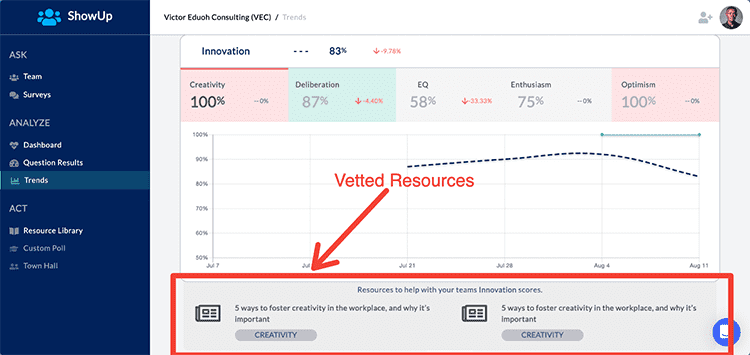Fostering a Culture of Innovation: 5 Ways for Managers to Get it Right
Let’s start this one with a fun, objective game.
From the options below, where did the idea to build the Playstation (Sony’s cash cow for several years) come from?
A. Sony’s President & Chairman, Norio Ogha, in the 1980s.
B. A Junior Staff on one of Sony’s engineering teams.
C. Sony’s top-line managers and executives, who all knew the company’s projections in the 1980s.
The correct answer is B!
Sony’s Playstation, which became an instant hit, proves why managers should foster a culture of innovation. And the reason for this is simple: Innovative ideas can come from the unlikeliest of employees you’re managing.
Instead of waving his idea aside, imagine if one of those top-line managers listened and deliberated on Kutaragi’s innovative idea. Don’t you think that manager would’ve risen with him as his innovation and fame took off?
I bet they would, but none did.
Today, Ken Kutaragi lives in Sony’s history books as a legend who went from just a Junior Staff to Sony’s CEO & President in 1999. We remember him for forcing his way to contact Norio Ogha directly. We don’t remember or have any records of the managers who turned him and his creative idea down.
Ken Kutaragi’s case isn’t a rare exception; there are many others.
However, I know you’re not like those Sony managers in the 1980s. You know encouraging creativity and listening to new ideas shared by employees builds an innovative culture that’s crucial to your company’s growth.
If you didn’t know, you'll not be here.
So in this guide, I’ll walk you through five ways to track, measure, and foster a culture of innovation, all from one team pulse survey software dashboard:
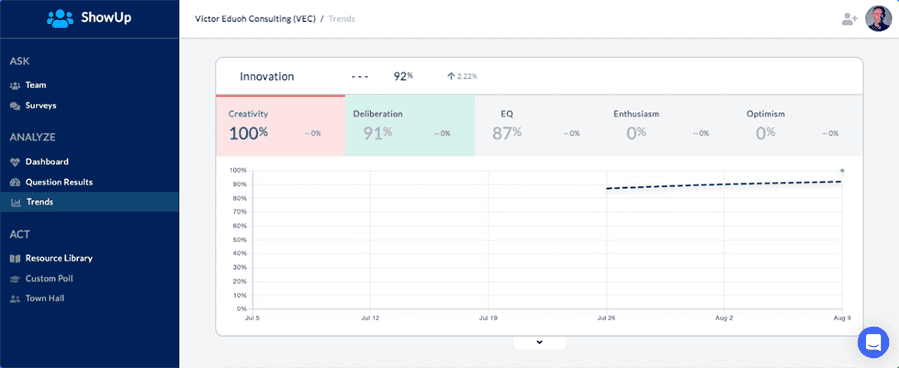
Here’s what I’ll cover (feel free to navigate by clicking below):
Table of Contents:
- Why Managers Fostering a Culture of Innovation is Important
- Five Proven Ways Managers Foster a Culture of Innovation
- How Team Pulse Surveys Fosters Culture of Innovation
- Reasons Managers Should Be Fostering An Innovative Culture
- Conclusion: Start Fostering an Innovation Culture by Giving Your Team a Voice
But in case you want to cut to the chase, you can take ShowUp a spin:
Automate Giving Employees a Voice.
Foster an innovative culture. All from one dashboard.
Why Managers Fostering a Culture of Innovation is Important
As a manager, you play an indispensable role in building an innovative culture.
Just to give you a clue, look at the illustration below:
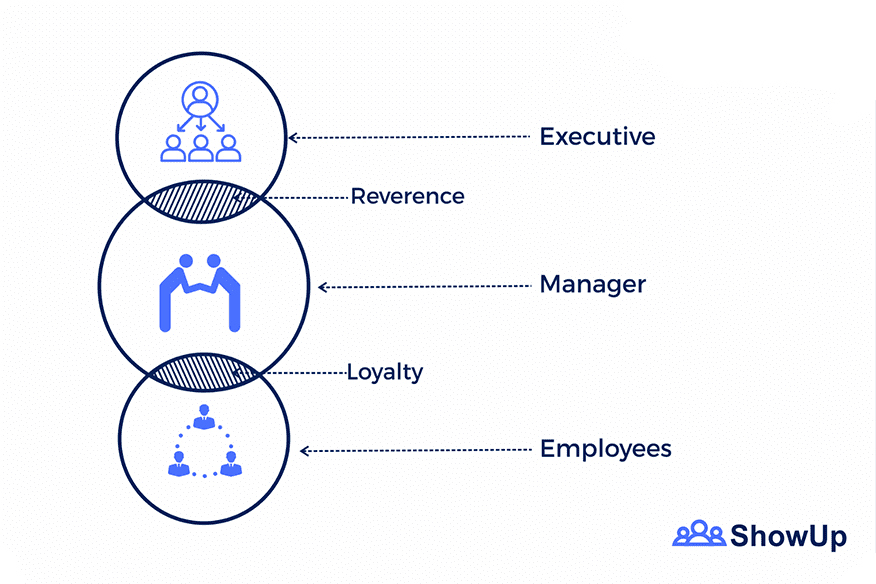
[source]
This image makes one thing clear: Fostering a culture of innovation involves enabling innovative ideas to flow from employees to executives and vice versa.
And managers are more likely enablers of this, Gallup’s study revealed.
According to the research, managers are responsible for a whopping 70% of the variance in employee engagement. Here’s what this means: As a manager, how you lead affects how engaged employees can be.
If employees you manage aren’t engaged, they won’t bring their best selves to work. Let alone become creative, identify, and share new ideas your company needs to innovate and capture new markets.
But go back to the illustration above for a second.
Did you notice two vital benefits managers stand to gain by fostering an innovative culture through enabling ideas to go from employees to executives and vice versa?
I’ll tell you:
- You’ll earn reverence from top executives who are always looking for vetted ideas to launch or expand into new markets.
- You’ll also earn loyalty from employees looking for an environment where collaboration thrives because it lets them express their creative ideas.
All this is why Speaker & Employee Engagement Thought Leader, Scott Russell, CRP, CEP, started one of his articles by saying:
Environments that allow employees to express their ideas and collaborate openly with coworkers can boost employee morale and overall engagement. By encouraging employees and giving them a voice, you can foster a positive work culture and gain fresh and exciting new ideas.
Five Proven Ways Managers Foster a Culture of Innovation
Fostering an innovative culture doesn’t mean you’ll entertain every random idea an employee conceives or has to share. At the same time, you don’t want to shut them up because their ideas look far-fetched at first glance.
Here’s how to avoid making either mistake.
As a manager, you can avoid the messy situation of not knowing ideas to consider or ignore. And it starts with improving employee engagement, according to Mischa Kaplan, HR Director at Ottawa Tourism.
Ultimately, it all comes down to engagement – how involved and dedicated an individual is to the job they hold. And to be clear, there is now an extensive body of academic research that has demonstrated a clear link between high levels of employee engagement and the frequency with which individuals engage in on-the-job innovation. Put another way, a workforce that is engaged is one that is more innovative.
In short, engagement leads to an always-evolving, three-step innovation cycle:
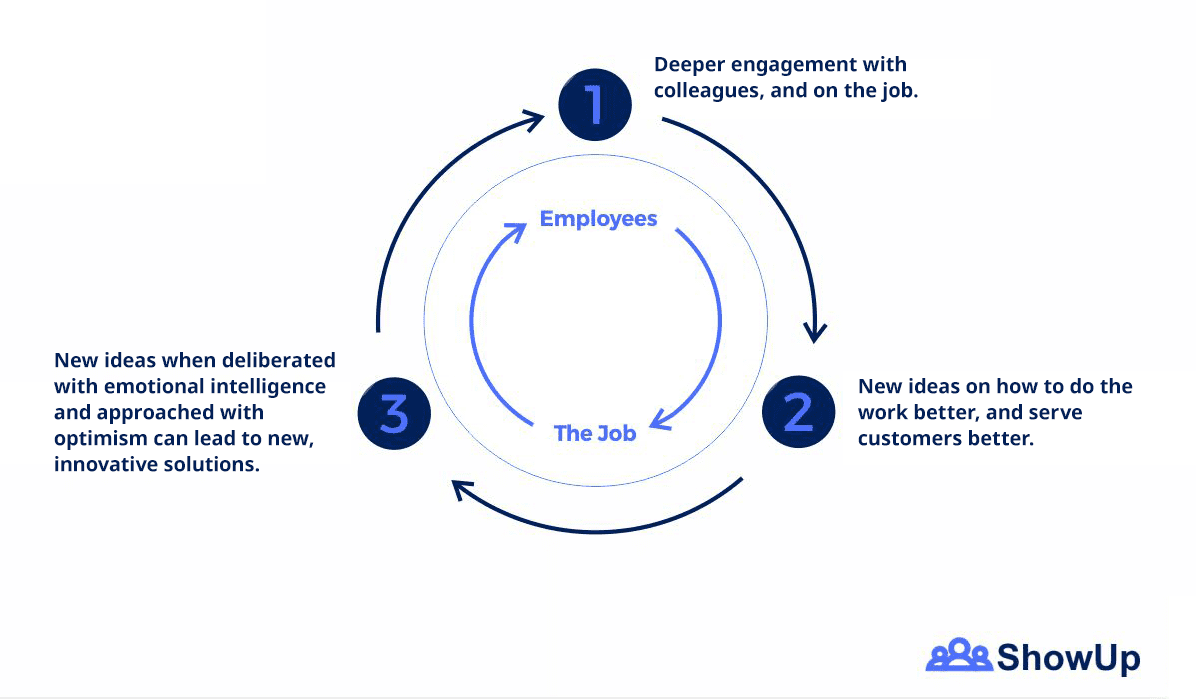
What follows are the five ways to implement this continuous, three-step process of fostering an innovative culture in your workplace. In the end, you’ll see how to achieve all these from a single software and dashboard.
Let’s dive in.
1. Encourage Creativity
Everyone has some form of creativity in them.
This creativity inherent in every individual is what leads to new ideas and innovations. So as a manager eager to foster innovation, the question you should always be asking is: How do I get everyone on my team to explore their inherent creative prowess?
You do this by encouraging creativity in your workplace through:
- Hosting of regular brainstorming sessions
- Allowing employees’ individuality to shine
- Providing an atmosphere that stimulates deep thoughts
- Facilitating anonymous suggestions.
2. Deliberate on Shared Ideas
When employees share new ideas, some managers either jump on each instantly, or they’ll just wave them aside. You should do neither.
Instead, discuss the idea to an appreciable length.
Deliberating on shared ideas helps you get the full context of how they sprung into your employees’ minds. And you can do this by:
- Asking why the idea makes sense to them
- Asking how it will make sense to your company, customers, or industry
- Asking how they came up with the idea, and
- Asking what problems they think the idea could solve.
One more thing before we proceed.
If you’re not seeking feedback on what employees think about ideas shared with you, chances are they’ll stop sharing. Unfortunately, if you manage over 15 employees, continuously asking for feedback can be a real pain in the ass.
And that’s where ShowUp team pulse survey software comes in:
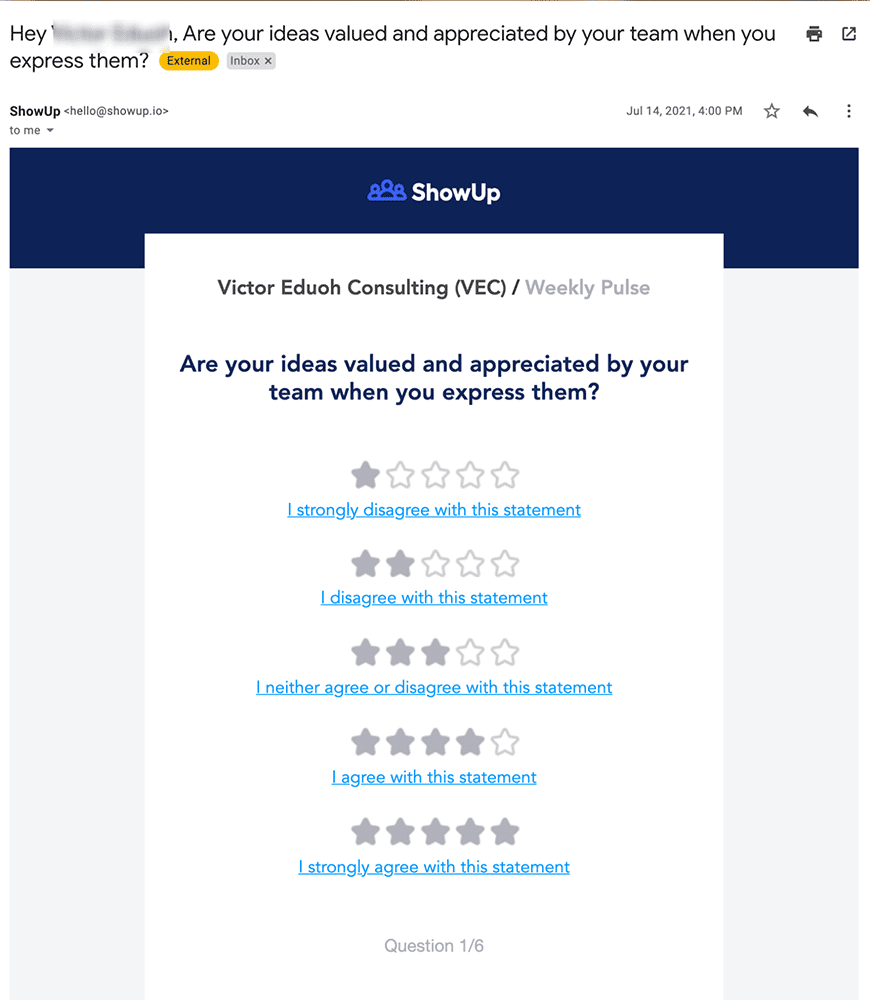
3. Approach Efforts with Optimism
Ken Kutaragi’s first approval to start work on the Playstation led to a partnership with Nintendo. Unfortunately, along the line, Nintendo pulled out of the agreement, and it appeared Ken’s dreams had come to an end.
But Norio Ogha’s optimism was bullish.
He gave him the needed support. Sony’s CEO at the time allowed Kutaragi to form his team and continue developing the Playstation. The rest, as they say, is history.
As a manager, this story should remind you to approach fostering an innovative culture with optimism. And you should do this even when things don’t go as planned initially.
Lisa Jasper is the Director of Performance at Insperity.
In one of her articles on how managers can practice optimism, she wrote:
Persistent and proactive: Optimistic leaders don’t give up easily, and they anticipate challenges before they happen. This broadens their horizons and helps them find solutions that step outside the expected box. Team coach: Optimistic leaders serve as a team coach, finding ways to energize, motivate and show confidence in their teams to help employees grow and develop.
4. Be Enthusiastic
The manner and attitude with which you approach things matter. And this is especially crucial to fostering a culture of innovation.
Here’s why.
If you approach employees’ creativity and innovative ideas with negativity, you’ll get negative outcomes. But by being enthusiastic and positive about new ideas, you’re more likely to foster a workplace culture where innovation thrives.
Randy Grieser, Author, Speaker, and CEO of ACHIEVE, agrees with this sentiment.
In one of his articles, Randy wrote:
Employees will not automatically be passionate about the work they do. Perhaps for a short time, they will, but if you are aiming for long-term engagement and excitement, you should be intentional about providing inspiration. Leaders inspire employees to be passionate by expressing genuine enthusiasm and articulating why the organization does what it does –why and how [your company] makes a difference.
5. Lead with Emotional Intelligence
Emotions affect creativity and, by extension, innovation. According to an excellent article by IdeaScale:
A [manager] who nurtures emotional intelligence for innovation purposes encourages employees to think outside the box when dealing with difficult situations.
When you lead with emotional intelligence, you can unlock higher levels of creativity that results in getting employees to:
- Express themselves freely
- Become more flexible
- Share their ideas
- Listen actively to you.
As a manager, you should take the last point seriously because it affects if you’ll achieve your goal of fostering an innovative culture. Natalie Kroc observed this in an article for SHRM.
Listen actively to what the employee is saying. Don't be afraid to be a little curious and ask a genuine question, which can show that you're trying to understand what the employee is going through [emotionally].
Since you’ve come this far, I have a quick question for you.
Did you notice the five traits across the five ways recommended for managers to foster innovation in their workplace and company?
In case you missed them, these traits are:
- Creativity
- Deliberation
- Enthusiasm
- Optimism, and
- Emotional intelligence (EQ)
It all starts with prioritizing employee engagement.
From there, it comes down to listening to employees’ ideas, getting their feedback, tracking and measuring these traits, and improving them consistently.
These traits are what drives the always-evolving innovative culture loop:
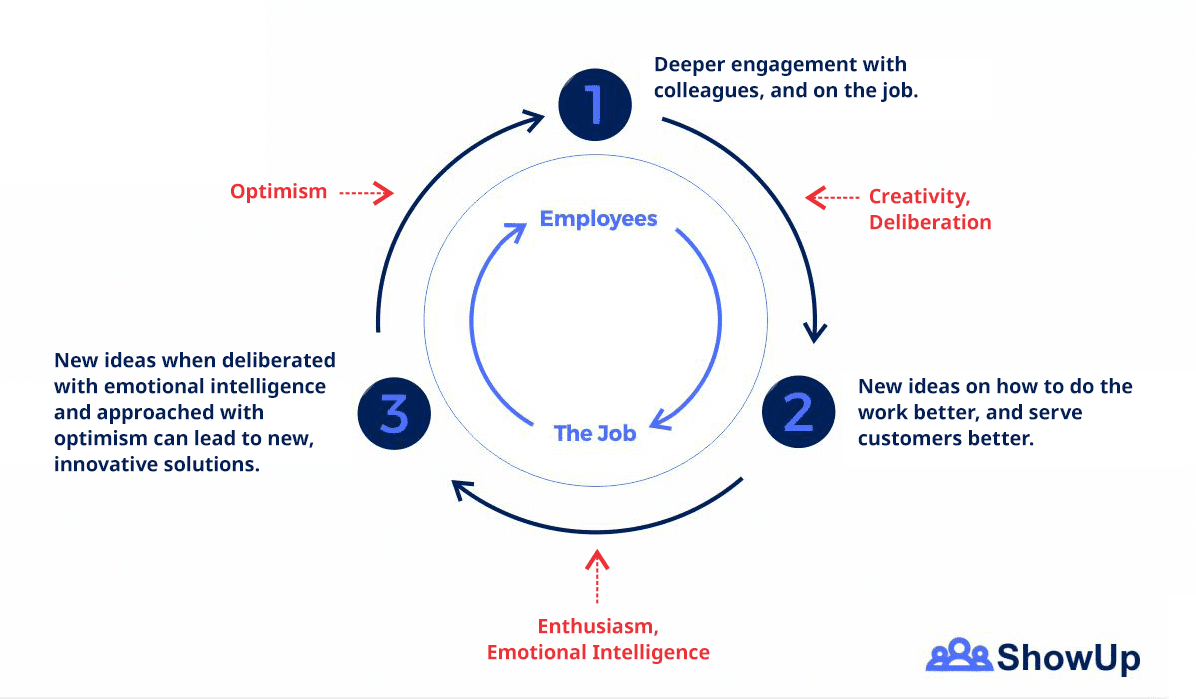
Now, the question is:
As a manager wearing many hats, how can you drive employee engagement, listen to employees for feedback, track, measure, and improve traits relevant to fostering an innovative culture, all at once?
This is where ShowUp’s automated team pulse surveys shine.
Let’s see it in action.
How Team Pulse Surveys Fosters Culture of Innovation
Team pulse survey software helps you track and measure traits relevant to improving employee engagement, of which one is innovation.
Take ShowUp, for example.
With its pre-built psychology-backed questions, you can survey employees on metrics relevant to fostering innovation in your workplace. All you need do is focus each survey on a trait you’re interested in tracking and improving.
Since we’re on innovation, you can focus this week’s survey on it:
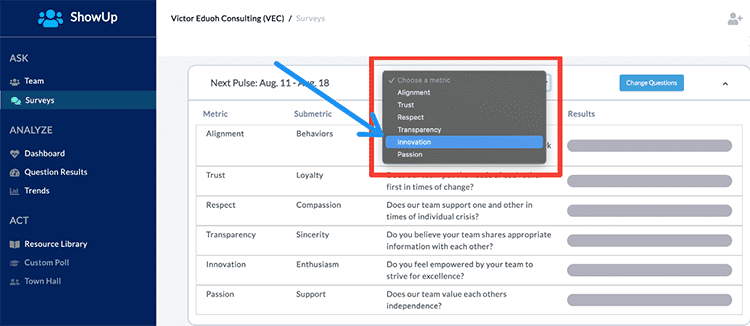
Once you do, the survey questions change automatically to focus on giving you insights on metrics relevant to fostering an innovation culture:
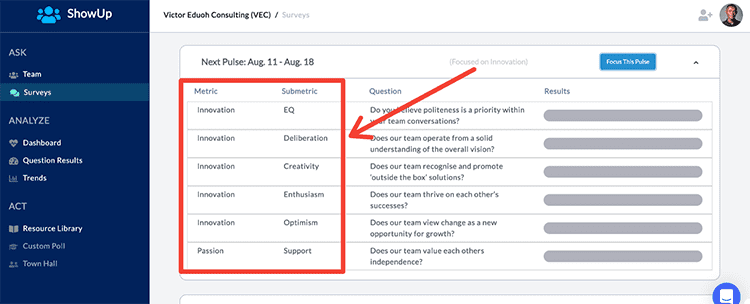
Each 6-question survey is fun and easy to complete.
Based on your preference, ShowUp sends these surveys to your employees’ email inboxes. And they can easily participate by choosing an option:
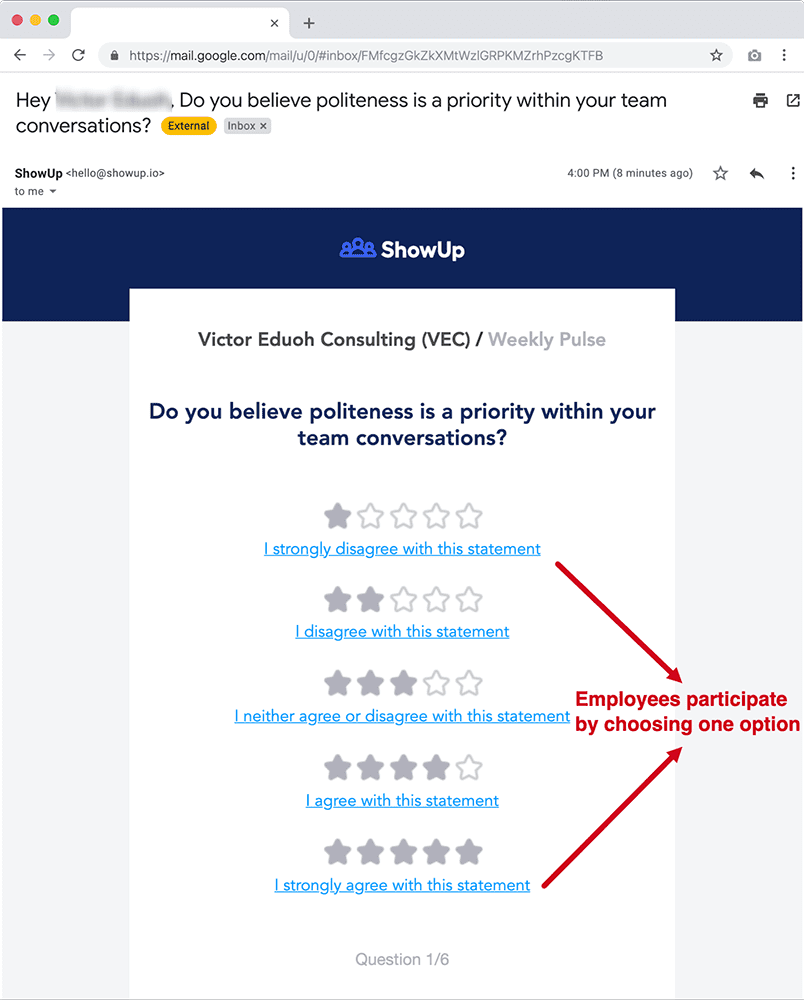
Once an employee chooses an option, ShowUp transitions them smoothly to complete the survey, anonymizing responses to encourage completion:
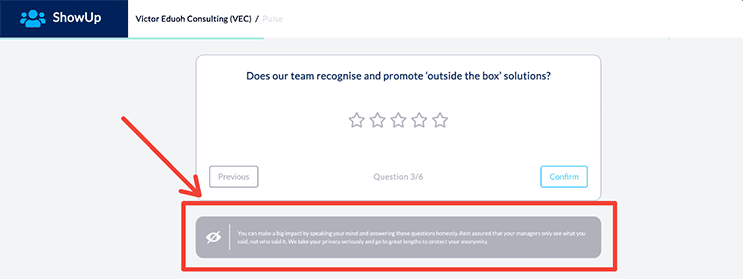
Automate Giving Employees a Voice.
Foster an innovative culture. All from one dashboard.
Reasons Managers Should Be Fostering An Innovative Culture
There are many benefits you can gain from giving employees a voice and fostering a culture of innovation. As I mentioned earlier, two standout benefits you can earn personally are:
- Reverence from executives who are always looking for vetted ideas to launch or expand into new markets, and
- Loyalty from employees looking for an environment where collaboration thrives because it lets them express their creative ideas.
Beyond these, there are even more reasons to take innovation in your workplace seriously.
Innovation Births Breakthrough Discoveries
Most breakthrough discoveries by companies you and I admire today came from having an innovative culture.
Take Amazon Prime, for example.
The idea of Amazon Prime came from a group of employees led by Greg Greely. It all started with them tinkering on how to improve Amazon’s “Super-Saver Shipping” offering.
Today, Amazon Prime drives over US$22 billion in yearly revenue.
An Innovative Culture Fuels Company Growth
Change is permanent.
As days go by, markets change, new competitors and alternative products try to snatch your customers, and customers seek new experiences. Staying on top of these trends leads to company growth.
Executive Trainer & Coach Theodore Henderson agrees.
In a Forbes’ article, he said:
When a company has an innovative culture, it'll grow easily, despite the fact that the creative process isn't always simple. Tried-and-tested methods may be reliable, but trying out new things is a worthwhile experiment.
It Helps in Attracting Top Talent
Attracting and retaining top talent and driving your company’s growth organically have something in common.
Two professors at Wharton University observed this in a podcast:
Firms that are ‘growth drivers’ distinguish themselves from ‘growth laggards’ in the way they attract, nurture and retain “innovation talent” to grow organically.’
They continued:
These ‘growth drivers’ validate their commitment to innovation with a reinforcing culture and ‘work systems,’ or supportive organizational structures and processes, they say. “Innovation talent” looks for such evidence and gravitates towards such organizations.
An Innovative Culture Helps Give Your Team a Voice
When asked how he led his team to come about the idea for Amazon Prime in this interview, Greg Greely said:
We wanted everyone to be thinking about ideas that’ll benefit customers. No one in the leadership team thought there was a monopoly on good ideas that could come from certain groups. In fact, we worked really hard to develop the muscles so we could surface ideas from across the company.
In other words, by fostering an innovation culture, Amazon ensured every employee had a voice to share their ideas. As a manager, you should do the same.
And here’s why.
Besides Amazon Prime, giving every employee a voice to share their creative ideas helped Amazon discover other innovative solutions. For instance, it enabled Peri Hartman, a programmer on one of Amazon’s engineering teams, to develop the “buy with 1-click' button.”
Conclusion: Start Fostering an Innovation Culture by Giving Your Team a Voice
Ideas are the seeds that birth innovation.
The good news is that everyone on your team has ideas, meaning the first difficult job in fostering an innovative workplace is yours for free. Your task then is to create an environment that encourages everyone to share ideas freely.
In other words, give your employees a voice.
And with ShowUp, not only can you do this, but you can also gather feedback on how employees feel about ideas they’re sharing with you. It’s crucial to do this to ensure continuous streams of new ideas:

Now, once your employees give you feedback, ShowUp collates their responses, crunches the data, and populates it in a dashboard for you.
This way, you can always track, measure, and get access to vetted resources to work on problem areas and foster a culture of innovation:
